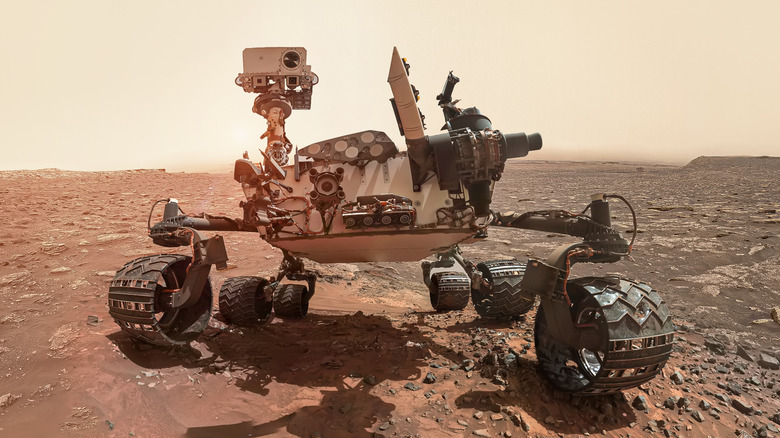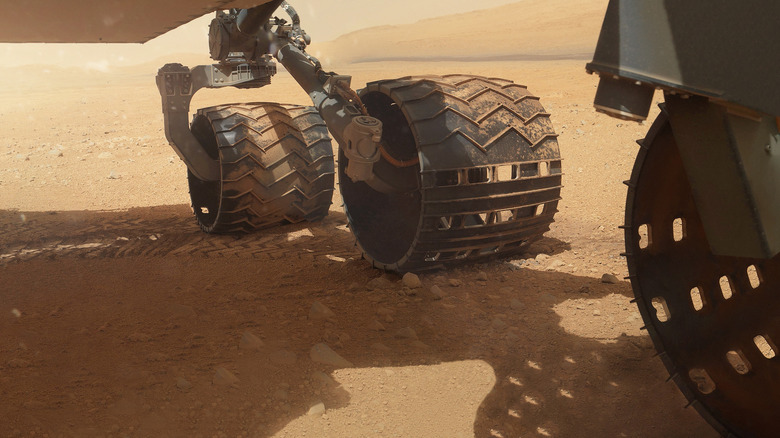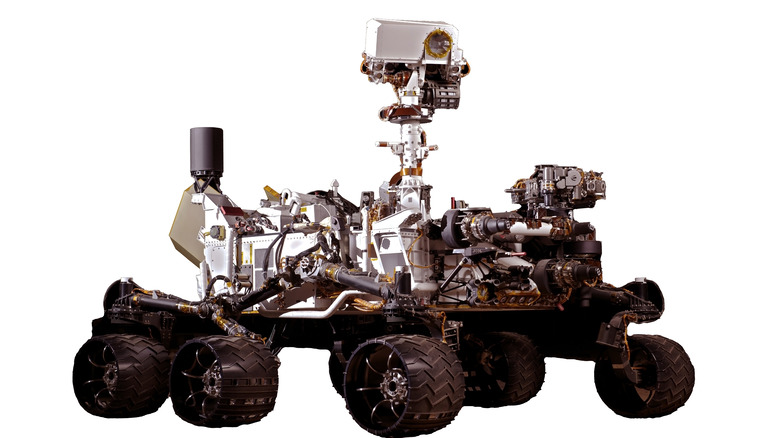These NASA Mars Rover Inventions Could Be In Your Next Car
NASA's space efforts have resulted in many spin-off products and technologies that we use in everyday life. In fact, NASA has highlighted this in an annual publication called Spinoff. The next great space frontier for human space exploration is Mars. Even though NASA has created a stimulated Mars habitat and SpaceX is planning a manned mission to Mars and establish a base on the red planet in the coming years, it is extremely inhospitable to human life. It has an extremely thin atmosphere and no magnetosphere like that protecting Earth. Radiation levels are very high, and the soil is also highly radioactive and toxic as a result (via phys.org). To help pave the way for human exploration of Mars, NASA has been sending spacecraft and rovers to the planet for many years now.
As Mars is such a tough environment, any vehicle that NASA designs to work on the surface of Mars has to be engineered to levels that exceed most of the tolerances that we would expect of a vehicle running on the Earth's surface. This means there is an excellent chance that any transferability of Martian rover tech developed for Mars missions will prove extremely resilient here on Earth. Like lunar missions and NASA's other space-faring efforts have demonstrated over the years, there are often many direct benefits for mere earthlings thanks to technologies developed for outer space.
Mars is a great proving ground for vehicular technology
According to Forbes, one of the key rover-specific technologies that could have practical applications here on Earth is unbreakable tires. Most of us know how annoying it is to experience a punctured car tire. The Martian surface is very rocky, and there are plenty of obstacles that a rover could cut a conventional tire rendering it basically inoperable.
That's why NASA has developed special unbreakable tires made from titanium and aluminum that, cost notwithstanding, could easily find applicability on Earth-bound off-road vehicles, whether for recreational or mission-critical commercial purposes. The wheels are so capable that NASA says they can roll over a rock of the same dimensions as the wheel itself. Regarding performance, Earth-based off-road vehicles have only one major drawback: ride comfort on regular road surfaces would be somewhat limited. The cost of materials like titanium could also be a drawback. However, a specialized off-road vehicle designed to explore rugged terrain could almost certainly adopt aspects of the rover's wheel and suspension designs to make them more durable.
NASA's Mars rover tech can work on Earth too
The Missouri University of Science and Technology is developing a "superlubricant" for Mars rovers that would help extend their service life when exposed to the Martian surface's extreme temperature and other climatic phenomena. It uses two-dimensional nanomaterials called MXenes to reduce wear from friction, with a friction coefficient of just 0.0067 to 0.0017. A coefficient of zero means no friction at all, highlighting just how lubricating the substance is. NASA's recent Martian rovers have exceeded all performance expectations, but the agency is still looking to push the performance of its rovers further.
Hired by NASA, researcher Pavlo Rudenko is also developing a new superlubricant that could also be used in future Mars missions. It uses nanoflakes that leave behind a diamond-like carbon coating inside the engine. Rudenko's company TriboTEX claims on its website that when added to an engine oil sump, the lubricant will boost horsepower by 3% and boost mileage by up to 5%. As with its lubricant for NASA's Mars rovers, the company claims it will protect a combustion engine from wear and even help repair damage to surfaces where it has occurred. However, you should always check with your car maker before introducing additives into your engine oil sump.
Other Mars rover tech we could see in cars
As IEEE Spectrum reports, NASA has developed what it calls the Modular Robotic Vehicle (MRV) using Mars rover tech in its design. It takes Mars rover mobility and control systems to create a vehicle that delivers drive to each of its four wheels with independent propulsion modules, unlike a conventional all-wheel drive system that usually delivers drive from a single powertrain. Each of the wheels also has its own steering system that can rotate up to 180 degrees for levels of agility not previously seen. In addition to a regular steering wheel, the test bed vehicle is also fitted with a multi-axis joystick that allows the MRV to drift in a way that a conventional steering system simply cannot manage.
While this mobility system isn't necessarily something we might see in a regular passenger vehicle, there could be a market for this technology in an industry like the mining sector, where fine levels of control and maneuverability in off-road and tight spaces could prove useful. It is also possible that similar technology could be deployed in off-road vehicles for those who like to navigate tough terrain where even an otherwise specialized four-wheel drive vehicle might not dare to tread.
With humans getting more serious about Mars exploration and potentially even sending manned rovers to Mars in the next decade, expect to see more Martian technology finding its way back to daily life back here on Earth.


